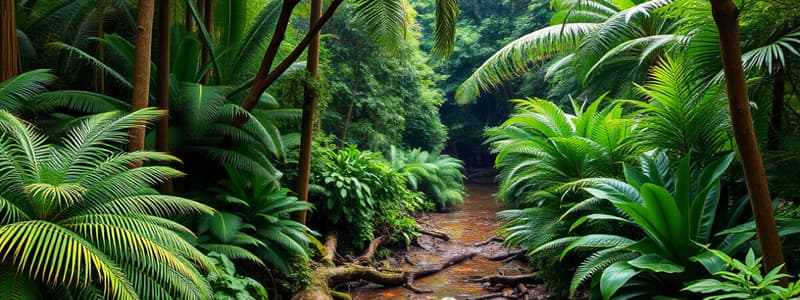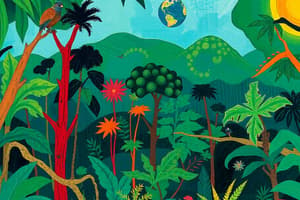Podcast
Questions and Answers
Which of the following are characteristics of tropical rainforests? (Select all that apply)
Which of the following are characteristics of tropical rainforests? (Select all that apply)
- Structure of tropical rainforest (correct)
- Diversity of plant species (correct)
- Sparse vegetation
- Adaptation of plants (correct)
What is the increase of rich biodiversity in tropical rainforests due to?
What is the increase of rich biodiversity in tropical rainforests due to?
Hot and wet environment
What types of food can be found in tropical rainforests?
What types of food can be found in tropical rainforests?
Fruits, spices, vegetables, nuts
What characterizes the emergent layer of a tropical rainforest?
What characterizes the emergent layer of a tropical rainforest?
Tall, straight trunks with branches spread out near the top compete for sunlight.
Tall, straight trunks with branches spread out near the top compete for sunlight.
What is the function of smooth barks in trees from the emergent layer?
What is the function of smooth barks in trees from the emergent layer?
What is the role of large buttress roots in tropical rainforest trees?
What is the role of large buttress roots in tropical rainforest trees?
Buttress roots are deep and seek underground water.
Buttress roots are deep and seek underground water.
What percentage of sunlight can thick and dense trees block in a tropical rainforest?
What percentage of sunlight can thick and dense trees block in a tropical rainforest?
What can be found in the canopy layer of a tropical rainforest?
What can be found in the canopy layer of a tropical rainforest?
What is the purpose of cling-on plants in tropical rainforests?
What is the purpose of cling-on plants in tropical rainforests?
Can you give examples of epiphytes?
Can you give examples of epiphytes?
What characterizes the undergrowth layer in tropical rainforests?
What characterizes the undergrowth layer in tropical rainforests?
Sunlight in the undergrowth layer is abundant.
Sunlight in the undergrowth layer is abundant.
Lack of sunlight in the undergrowth layer causes plants to be _____, _____, and _____ spaced.
Lack of sunlight in the undergrowth layer causes plants to be _____, _____, and _____ spaced.
What is caused by the hot and wet environment of tropical rainforests?
What is caused by the hot and wet environment of tropical rainforests?
How do leaves minimize moisture loss in tropical rainforest conditions?
How do leaves minimize moisture loss in tropical rainforest conditions?
What features do leaves have to prevent fungi and bacteria from growing on them?
What features do leaves have to prevent fungi and bacteria from growing on them?
Why are fruits and flowers colorful and strong-smelling in tropical rainforests?
Why are fruits and flowers colorful and strong-smelling in tropical rainforests?
Seed dispersal and pollination by wind is easy in tropical rainforests.
Seed dispersal and pollination by wind is easy in tropical rainforests.
Flashcards are hidden until you start studying
Study Notes
Characteristics of Tropical Rainforests
- Tropical rainforests exhibit high diversity of plant species.
- Structure features distinct layers: emergent, canopy, and undergrowth layers, each with specialized adaptations.
Biodiversity
- Rich biodiversity results from a hot and wet environment conducive to plant and animal life.
Available Food Types
- Commonly found foods include:
- Fruits
- Spices
- Vegetables
- Nuts
Emergent Layer
- This layer comprises the tallest trees, often exceeding 30 meters.
- Trees rise several meters above the canopy layer to access sunlight.
Tree Adaptations in the Emergent Layer
- Tall, straight trunks with branches concentrated at the top maximize sunlight access.
- Smooth bark facilitates efficient water flow from leaves to roots.
Root Structures
- Large buttress roots extend 1-5 meters above the ground, providing stability.
- Shallow buttress roots are sufficient due to nutrient-rich top soil created by rapid decomposition.
Canopy Layer
- Located 20-30 meters above ground, this layer features numerous vines and epiphytes.
- Epiphytes, such as ferns, orchids, and mosses, grow on trees to optimize sunlight exposure.
Undergrowth Layer
- Characterized by darkness and density, receiving little sunlight due to blockage by the canopy.
Adaptations to Low Light
- Sparse vegetation with small, thin, and widely spaced plants.
- Vegetation develops larger leaves to capture more sunlight.
Environmental Conditions
- Hot and wet climates allow for rapid decomposition, resulting in a thin layer of leaf litter.
Leaf Adaptations
- Leaves often possess waxy, leathery, or hairy surfaces to reduce moisture loss via transpiration.
- Narrow, downward-pointing tips help water runoff, preventing fungus and bacteria growth.
Attractive Fruits and Flowers
- Brightly colored and fragrant fruits and flowers serve to attract pollinators and seed dispersers.
Seed Dispersal and Pollination
- Wind-based dispersal and pollination are challenging due to still air and minimal wind presence in the rainforest.
Studying That Suits You
Use AI to generate personalized quizzes and flashcards to suit your learning preferences.



